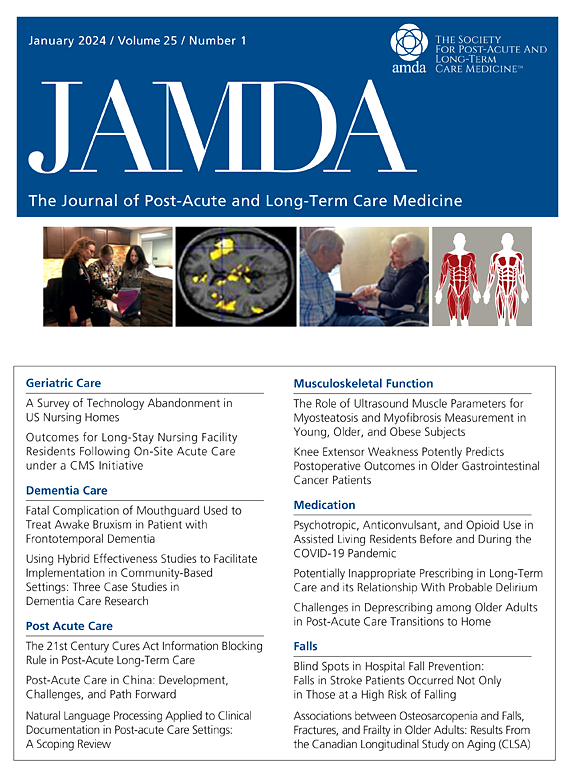Development, Validation, and Application of the Electronic Frailty Index: A Scoping Review
IF 4.2
2区 医学
Q2 GERIATRICS & GERONTOLOGY
Journal of the American Medical Directors Association
Pub Date : 2025-05-14
DOI:10.1016/j.jamda.2025.105577
引用次数: 0
Abstract
Objective
The aim of this scoping review was to examine the scope and characteristics of the published literature related to the Electronic Frailty Index (eFI).
Design
Scoping review.
Setting and Participants
Original studies related to the eFI in older adults.
Methods
Six databases were searched for articles published between March 2016 and August 2024: PubMed, Web of Science, Cochrane Library, Scopus, China National Knowledge Infrastructure (CNKI), and Wanfang Database. Data extracted included the publication year, country, sample size, data sources for developing an eFI, number of items included in the eFI, performance of the eFI, and application of the eFI.
Results
Of the 424 articles initially retrieved, this scoping review included 50 studies for analysis. Thirty-nine (78%) of these studies were conducted after the year 2019. Moreover, we identified 8 distinct eFIs. Twelve studies assessed the performance of eFIs, whereas 30 studies used them. The eFIs covered 4 key domains: diseases, functional information, laboratory tests and measures, and symptoms and signs. The most common outcome examined was mortality. Furthermore, the eFIs were applied for diverse purposes, including exploring the relationship between frailty and health outcomes.
Conclusions and Implications
This scoping review revealed that eFIs can be developed using various electronic health care data sources, and they have been extensively employed for various population-level purposes. The observed associations between the eFIs, existing frailty assessment tools, and health outcomes highlight their utility in evaluating the care needs of an aging population.
电子脆弱指数的发展、验证和应用:范围综述。
目的:本范围综述的目的是检查与电子衰弱指数(eFI)相关的已发表文献的范围和特征。设计:范围审查。背景和参与者:与老年人eFI相关的原始研究。方法:检索2016年3月至2024年8月间发表的文章,检索PubMed、Web of Science、Cochrane Library、Scopus、CNKI和万方数据库。提取的数据包括出版年份、国家、样本量、开发eFI的数据源、eFI中包含的项目数量、eFI的性能以及eFI的应用。结果:在最初检索到的424篇文章中,本综述纳入了50篇研究进行分析。其中39项(78%)研究是在2019年之后进行的。此外,我们确定了8种不同的efi。12项研究评估了efi的表现,而30项研究使用了它们。efi涵盖4个关键领域:疾病、功能信息、实验室检测和措施以及症状和体征。最常见的结果是死亡率。此外,efi被用于多种目的,包括探索虚弱和健康结果之间的关系。结论和影响:这一范围审查表明,可以使用各种电子卫生保健数据源开发efi,并且它们已广泛用于各种人口水平的目的。观察到的efi、现有的衰弱评估工具和健康结果之间的关联突出了它们在评估老龄化人口的护理需求方面的效用。
本文章由计算机程序翻译,如有差异,请以英文原文为准。
求助全文
约1分钟内获得全文
求助全文
来源期刊
CiteScore
11.10
自引率
6.60%
发文量
472
审稿时长
44 days
期刊介绍:
JAMDA, the official journal of AMDA - The Society for Post-Acute and Long-Term Care Medicine, is a leading peer-reviewed publication that offers practical information and research geared towards healthcare professionals in the post-acute and long-term care fields. It is also a valuable resource for policy-makers, organizational leaders, educators, and advocates.
The journal provides essential information for various healthcare professionals such as medical directors, attending physicians, nurses, consultant pharmacists, geriatric psychiatrists, nurse practitioners, physician assistants, physical and occupational therapists, social workers, and others involved in providing, overseeing, and promoting quality

 求助内容:
求助内容: 应助结果提醒方式:
应助结果提醒方式:


